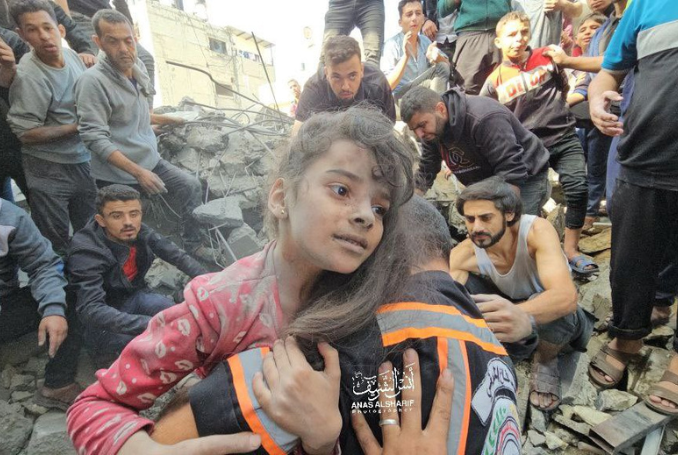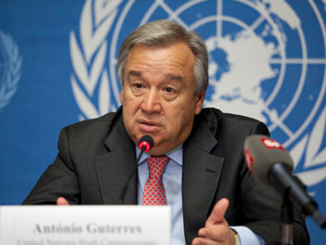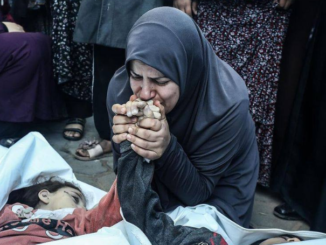
By Kathy Kelly
We can’t help but ask whether Israeli officials see the potential for widespread disease as motivation for families to leave Gaza, accepting massive ethnic cleansing that would displace them beyond Gaza’s borders.
Speaking from a hospital ward about 50 meters from where a bomb had just exploded, UNICEF spokesperson James Elder raised his voice over the sounds of children screaming.
In a video posted on Twitter/X, he emphasized that Gaza’s healthcare system is overwhelmed. Pointing at children packed into the ward of a hospital he said was operating at 200 percent capacity, Elder insisted the hospital “cannot take more children with the wounds of war…with the burns, with the shrapnel littering their bodies, with the broken bones.”
Calling it a war on children, Elder warned that “inaction by those with influence is allowing the killing.”
We, the citizens of the world, are those with influence as well as our elected officials. It is the citizens of the world who came out by the hundreds of thousands in recent weeks that caused the woefully inadequate gesture of a seven-day truce. Now we must urgently pay heed to another persecution of Gaza’s children and families, waged by one of war’s more silent partners, disease.
Those with influence among authorities in Israel and the United States must reckon not only with the reckless carnage they are inflicting on children. They must also grasp the likelihood of an exponentially increased death toll from battlefield illnesses afflicting children.
Surviving Gazans live amid ominous pre-conditions for outbreaks of water-borne diseases especially deadly to children: a mounting number of unburied corpses, unsafe drinking water, overcrowding in impromptu mass shelters where sick people are denied any access to health care, as well as a breakdown of basic sewage and sanitation systems.
The World Health Organization warns that Gaza is “on the precipice of major disease outbreaks.”
On November 15, 2023, the World Health Organization reported more than 44,000 cases of diarrhea had been documented in Gaza since mid-October — already a dramatic increase compared to previous years and after only two months of the bombardment.
“Eventually we will see more people dying from disease than from bombardment if we are not able to put back together this health system,” said Margaret Harris, a spokesperson for the WHO.
Yet. without electricity and fuel, it’s impossible to repair Gaza’s collapsed healthcare system. Israeli authorities cut off Gaza’s electricity supply after October 11, according to UNOCHA, and fuel reserves for Gaza’s sole power plant have been dangerously depleted.
History repeatedly shows that children in war zones bear the brunt of punishment as bombing wars give way to even more lethal economic war, and what ought to be regarded as biological warfare against children. (It’s noteworthy that Israel is one of only eight world nations not to have signed the Biological Weapons Convention.)
The suffering inflicted on Iraqi children following the 1991 war and ensuing years of merciless economic sanctions is well known to US and Israeli authorities
When the US Desert Storm bombing war against Iraq ended, on Feb 28, 1991, a new kind of warfare proved far more devastating than even the worst of the bombing. By 1995, UN workers recognized that children were dying, first by the hundreds, then by the thousands, and eventually by the hundreds of thousands because economic sanctions prevented necessary access to medicines, clean water, and adequate food.
The US military itself predicted epidemic levels of waterborne diseases would break out, in Iraq, because the US bombing had so badly damaged the country’s underground water pipelines, causing cracks allowing sewage to seep into water used by civilians. Thirteen years of punitive economic sanctions cost the lives of countless Iraqis who couldn’t possibly have been held accountable for the actions of their government, – elderly people, sick people, toddlers and infants.
A similar pattern emerges if we turn our gaze toward the Saudi aerial bombing of Yemen from 2015 to 2018. The Saudi attacks against vital sewage and sanitation facilities, and against the electrical plants which powered them, contributed to severe shortages of potable water. The Saudis were also known to bomb sites where Yemenis were digging their own wells.
A report from Save the Children, issued in November 2018, estimated at least 85,000 children died from extreme hunger since the war began in 2015. The worst cholera outbreak ever recorded infected 2.26 million and cost nearly 4,000 lives.
Attacks on hospitals and clinics led to closure of more than half of Yemen’s prewar facilities. Besieged on all sides, 3.65 million Yemenis were internally displaced. An entire generation of Yemeni children will suffer the trauma and disease caused by Saudi bombings using weapons supplied by US. and other western manufacturers.
Dr. Yara Asi, a professor of global health management, points out that “the Gaza Strip had fragile health and water, sanitation and hygiene sectors long before the Oct. 7, 2023, Hamas attack that killed 1,200 Israelis and prompted the retaliatory airstrikes. The health system of Gaza, one of the most densely populated places in the world, has long been plagued by underfunding and the effects of the blockade imposed by Israel in 2007.”
In early 2023, an estimated 97% of water in the enclave was unfit to drink, and more than 12% of child mortality cases were caused by waterborne ailments. Diseases including typhoid fever, cholera and hepatitis A are very rare in areas with functional and adequate water systems.
Now, OCHA reports over 1.8 million people in Gaza, or nearly 80 per cent of the population, are internally displaced. Overcrowding at makeshift UNRWA shelters significantly increased cases of diarrhea, acute respiratory infection, skin infection, and lice. Without wells and water desalination, dehydration and waterborne diseases are mounting threats.
We can’t help but ask whether Israeli officials, intent on continuing the war for possibly as long as a year, see the potential for widespread disease as motivation for families to leave Gaza, accepting massive ethnic cleansing that would displace them beyond Gaza’s borders.
In a recently published investigation by +972 Magazine and Local Call, an Israeli intelligence veteran notes Israel’s detailed information on where Gazan civilians are located:
“Nothing happens by accident … When a 3-year-old girl is killed in a home in Gaza, it’s because someone in the army decided it wasn’t a big deal for her to be killed – that it was a price worth paying in order to hit [another] target. We are not Hamas. These are not random rockets. Everything is intentional. We know exactly how much collateral damage there is in every home. “
Rather than wait for Gazan parents to dig graves for the children sickened by lethal water-borne diseases, we must clamor for a permanent cease fire, reparations, and an end to Israel’s apartheid regime. In the United States, we must truthfully diagnose our diseased foreign policy, sickened for many decades by greed, fear and an addiction to war.
Worldwide, people are demonstrating their commitment to care about the Gazan children who survive this hideous war. The call for a permanent ceasefire includes the utter rejection of weaponizing disease to collectively punish children.

–Kathy Kelly, a peace activist and author, co-coordinates the Merchants of Death War Crimes Tribunal and is board president of World Beyond War. She contributed this article to The Palestine Chronicle.







